Justice A.K. Rajan
The report of the high level committee headed by Justice A.K. Rajan on the impact of National Eligibility-cum Entrance Test (NEET) has created a lot of discussion in Tamil Nadu. In this interview with The Hindu, Justice Rajan speaks about certain key aspects of the report. Edited excerpts:
There appears to be widespread consensus among political parties in Tamil Nadu that NEET should be abolished. However, the difficulty seems to be in figuring out how to do that. What are the recommendations that you have made on this?
I have given two recommendations. First is that the existing laws itself are adequate to eliminate NEET for admissions to government-run medical colleges affiliated to Tamil Nadu Dr. MGR Medical University (TNMGRMU). This is because entry 32 of List II (State List of Schedule 7 of the Constitution of India) clearly places incorporation, regulation and winding up of universities exclusively under the State government’s purview. Moreover, entry 44 of List I (Union List) excludes universities from the Union government’s purview.
That makes it clear that only State government has powers to make laws regarding regulation of universities run by it, including matters related to admission, award of degrees etc. This power has been exercised to create TNMGRMU through the TNMGRMU Act. Consequently, only TNMGRMU has the rights to decide on matters related to admissions. Union government cannot make any law for this. Therefore, NEET is not applicable at all in so far as the government medical colleges are concerned. The Act 3 of 2007 (Tamil Nadu Admission in Professional Educational Institutions Act), which abolished the Common Entrance Test (CET) and made Plus Two marks the criteria for admissions to professional courses, is still valid for medical colleges run by the State government.
If the government was not willing to take this advice, a separate law can be enacted similar to Act 3/2007, in which both government and self-financed medical colleges can be brought under the purview. This is what the government has done now.
The President had declined assent to similar NEET exemption bills in the past. How hopeful are you that the recent bill will receive his assent?
The present government has made a much stronger case this time with the bill. Therefore, a different view may be taken. This bill need not face a similar fate. For example, then Chief Minister Jayalalithaa passed a bill to abolish CET [for State Board students]. However, that was struck down. Later, when the DMK came to power in 2006, an expert committee was formed under (late) Dr. M. Anandakrishnan (former Vice Chancellor of Anna University). Based on its recommendation, another bill was passed to eliminate CET, which received President’s assent.
Apart from data showing reduced number of students from government schools, Tamil medium and rural background entering MBBS courses since NEET, your report also argues that NEET will severely affect availability of doctors in rural areas. However, there is criticism that this is only hypothetical as the first batch of MBBS students who got admitted through NEET have not even completed their course. How do you substantiate this argument?
It is fine if people do not want to believe in the report. They can independently collect data on the profile of doctors, particularly their community, working now in Tamil Nadu’s Primary Health Centres. That will make it clear on who are serving in rural areas.
It is also common sense to think whether students born and brought up in cities like Chennai with modern living conditions and amenities would be interested in serving in remote rural areas.
With the present regulations in force, more students from other States are joining medical courses here. Despite signing a bond that they will serve for at least two years in the State, they are not coming forward to serve. If they are unwilling to serve within the State itself, how can they be expected to serve in rural Tamil Nadu.
Moreover, the concept of awarding extra marks during the selection to higher studies for doctors who served in rural areas does not exist anymore. This earlier served as an incentive for serving in rural areas.
The data provided in the report shows that government school students were at a disadvantage in joining MBBS even before NEET. Your report talks about the need to reform school education and move from ‘coaching’ towards ‘learning’. Can you elaborate?
The data shows that 99 percentage of students who got admitted post-NEET had gone for coaching. This data is now collected as part of the application process. Coaching focuses only on preparing students to answer questions asked in the particular exam as opposed to learning a subject. We knew that, even before NEET, many private schools were ignoring Plus One and only teaching Plus Two syllabus for two years. Such practices should be avoided. The Plus Two examination must have questions from Plus One syllabus also. Teachers must also discharge their duty conscientiously.
An interesting recommendation in your report is the ‘adversity scores,’ suggesting that a framework can be developed to adjust Plus Two marks of students from disadvantaged and underprivileged background depending on the social, economic, and other demographic adversities that affected their academic performance. However, it might be argued that the reservation policies addressed such disadvantages. Can you explain the need for such a recommendation?
Reservation dealt with one aspect. In addition to that, the idea of adversity scores is to address other factors like income levels, rural background etc. I understand that it is an idea that may not find ready acceptance. I have read an incident about late Chief Minister K. Kamaraj. I am not sure how far it is true. Once, senior officials had difficulty in choosing from applied candidates for admission to medical colleges under CM’s quota. Finally, Kamaraj himself went through the applications and chose swiftly. When officials were surprised, he said that he chose the applications where the parents had given thumb impressions instead of signatures, indicating that they were unlettered. That was in a way an example of using adversity score.
Courtesy: ‘The Hindu’







